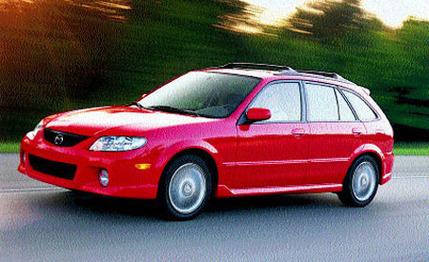 Short Take Road Test
Short Take Road Test
As quite often happens with image makeovers, the advertising has gotten ahead of the product. You've seen the "zoom-zoom" campaign Mazda is airing to inform us of its positioning as the sporty import brand within the Ford family of fine cars? It rings a little hollow now, with the MX-5 Miata standing as the only convincing sports car, but each of the company's new offerings will step in that direction, and maybe by the time the snot-nosed kid in the TV spots is terrorizing driver's-ed teachers, "zoom-zoom" will fit.
The Protegé lineup is morphing toward sportiness with the new MP3 sedan we showed you last month, as well as with this roarty little two-box 2002 Protegé5 (for five-door, gittit?). Impatient readers who've already skipped ahead to the spec panel will be unconvinced that a 9.5-second mini-breadbox could ever qualify as sporty, but they have yet to play chase with a Lingenfelter Corvette on twisty Michigan back roads in a Protegé5.
The setting was last month's Supertuner Challenge. The mini-Mazda was on hand as an errand boy and was being used as a shuttle en route to the next driver change during the road drive. But as we took off, we noticed there was no map in the Protegé5 — so we had to keep up with the car ahead. The 650-hp Lingenfelter Twin-Turbo Vette had a 520-hp advantage plus a high-g tire-and-suspension setup, but the nimble little wagon managed to keep within view. And although public-road prudence restrained the Corvette to probably three- or four-tenths of its capability, the equally prudent Protegé5 pilot was enjoying the full potential of his mount and grinning from ear to ear.
The new-for-2001 ULEV 2.0-liter engine, standard on Protegé5 wagon and ES sedan models, is a stroked version of the previous 1.8 and adds 8 horsepower and 15 pound-feet to the Protegé ES's comparo-winning formula (C/D, June 2000), for a total of 130 horsepower and 135 pound-feet. The added oomph doesn't quicken the pace, however, due to an increase in weight. The wagon bodywork adds about 80 pounds, but along with extensive structural enhancements (thicker shock-tower metal, additional crossbars, and general beefing up) and additional sound-deadening materials, our test vehicle carried an extra 255 pounds' worth of paunch relative to that of our last Protegé ES test car. This explains the 0.6-second delay in the 5's performance to 60 mph. But the engine revs so willingly and enticingly to (and past) the redline that the car feels quicker than its 17.2-second, 81-mph quarter-mile suggests.
We've had nothing but nice things to say about Protegé steering and handling, but the zoom-zoom team saw fit to reduce friction in the steering system and recalibrate the power-steering effort — and managed not to screw it up. The helm points the 5's standard 16-inch wheels and V-rated Dunlop SP Sport rubber with Germanic accuracy. A strut-tower brace helps keep that response linear when operating in 10/10ths Lingenfelter-pursuit mode. Lateral grip is just 0.79 g, but the exceptionally rigid chassis and the well-mannered limit handling (which becomes nicely neutral off the throttle) allow a skilled driver to wring the utmost speed out of that grip without soiled shorts.
To the scintillating driving dynamics, add supportive seats, an interior decked out with faux suede door inserts, faux carbon fiber, mod dimpled vinyl on the dash, and instrument lettering that's leaned back for speed, and you have a car with real personality. Cheeky. Insolent. Pert. A car much better suited to wearing a spiky-haired Calvin decal than the Ford and Chevy trucks he usually adorns. But then, what would he piss on? The PT Cruiser? The Impreza Sport wagon? The upcoming Pontiac Vibe or Toyota Matrix?
Those are the obvious sport-wagon competitors in the Protegé5's price range (from $16,815). The retro Cruiser isn't as fun to drive but offers a much more flexible cargo area. The Impreza, the Vibe, and the Matrix might cost more but will offer 35 to 50 more horsepower in top trim and more hauling volume, too. In fact, space is a bit tight in the Protegé5, as wagons go. It swallows just 20 cubic feet of cargo with the seats up, 24 with them down. That's less than half the space available in the smallest wagon in our 2001 New Car Guide, the Ford Focus wagon. At least luggage rails are provided for a rooftop carrier attachment.
But hey, it looks good, it's fun, and most of the Calvin types we know don't place practicality too terribly high on their list of purchase priorities.